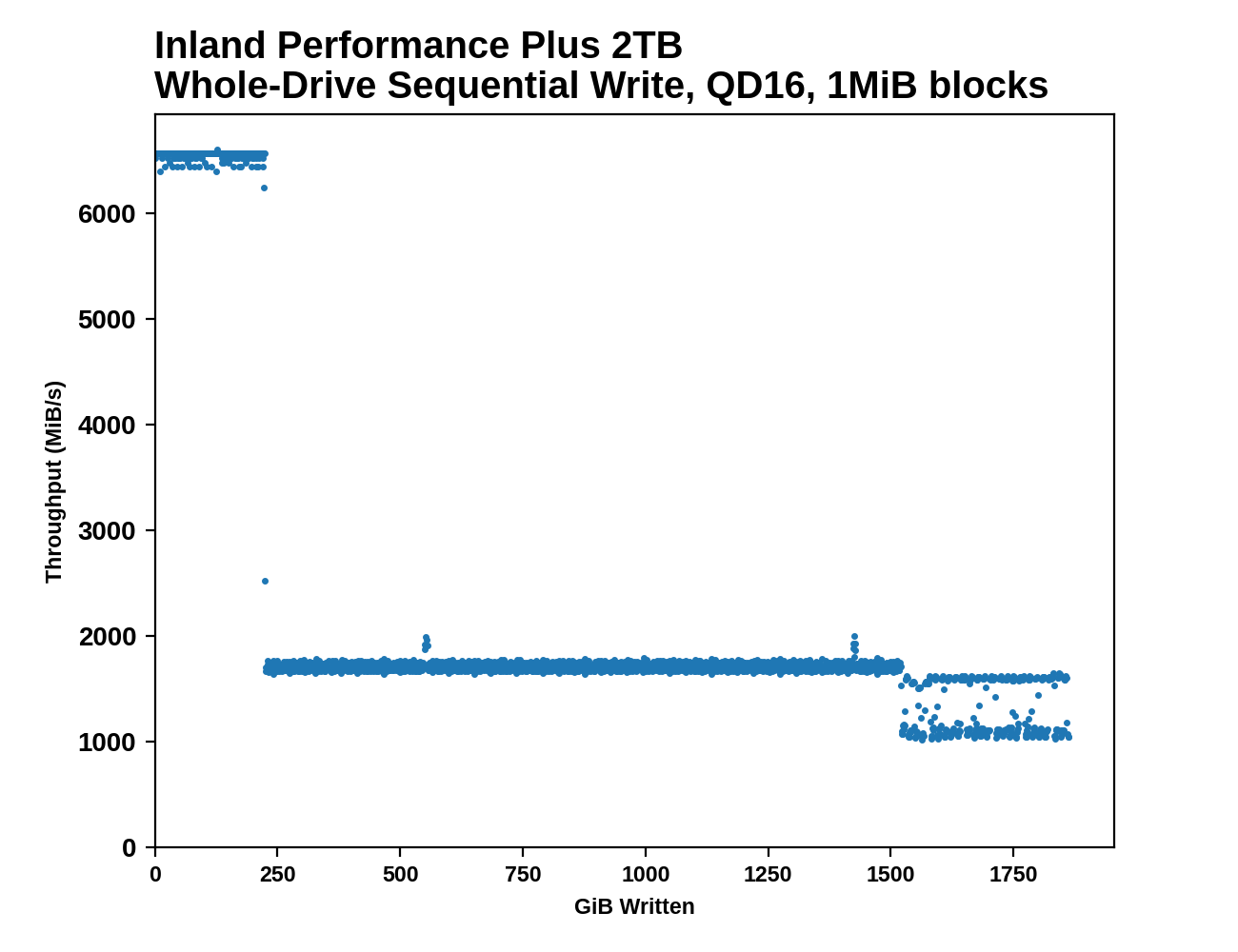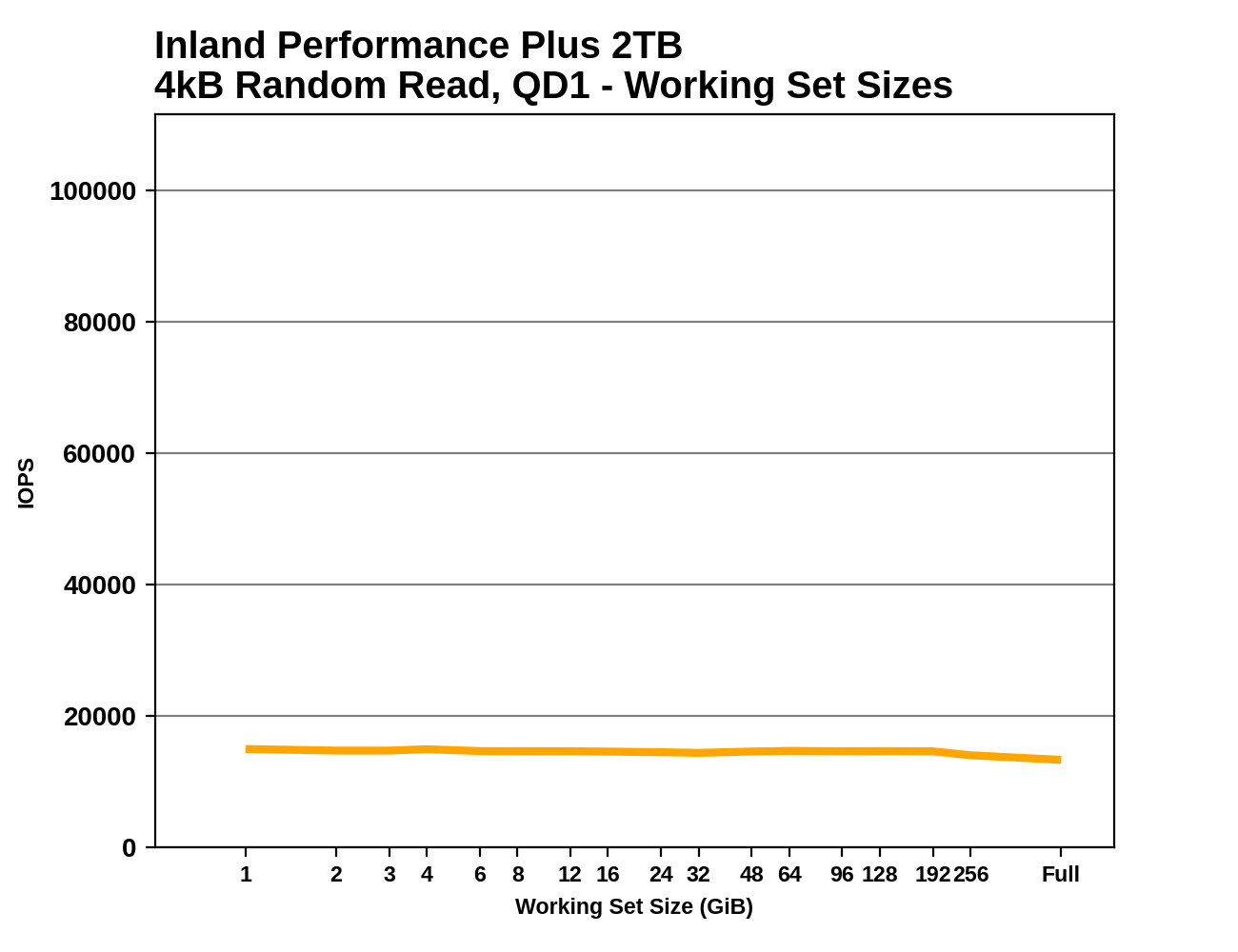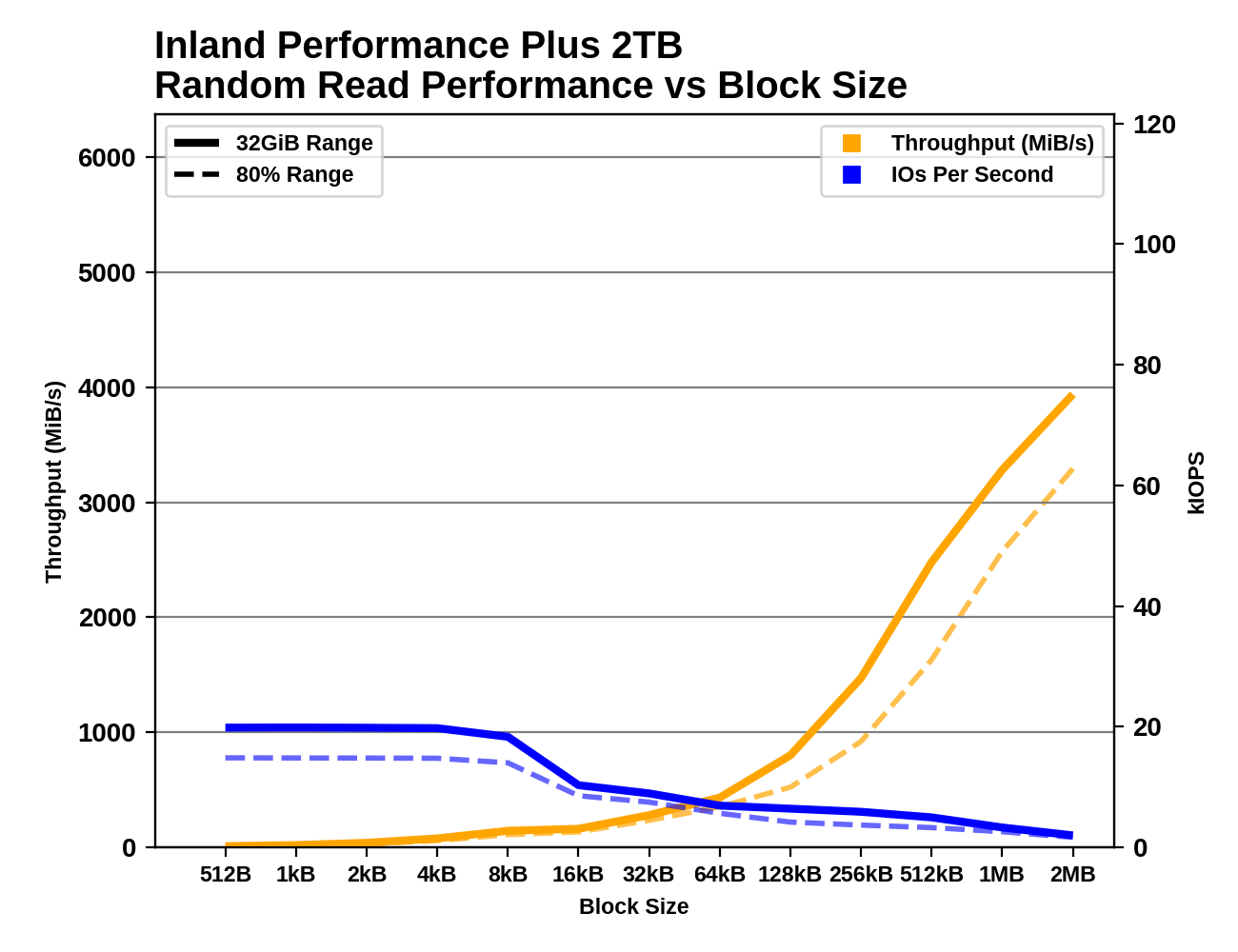The Inland Performance Plus 2TB SSD Review: Phison's E18 NVMe Controller Tested
by Billy Tallis on May 13, 2021 8:00 AM ESTAdvanced Synthetic Tests
Our benchmark suite includes a variety of tests that are less about replicating any real-world IO patterns, and more about exposing the inner workings of a drive with narrowly-focused tests. Many of these tests will show exaggerated differences between drives, and for the most part that should not be taken as a sign that one drive will be drastically faster for real-world usage. These tests are about satisfying curiosity, and are not good measures of overall drive performance. For more details, please see the overview of our 2021 Consumer SSD Benchmark Suite.
Whole-Drive Fill
 |
|||||||||
| Pass 1 | |||||||||
| Pass 2 | |||||||||
The SLC write cache on the 2TB Inland Performance Plus lasts for about 225GB on first pass (about the same cache size as 980 PRO, but a bit faster), and about 55GB on the second pass when the drive is already full. Performance during each phase of filling the drive is quite consistent, with the only significant variability showing up after the drive is 80% full. Sequential write performance during the SLC cache phase is higher than any other drive we've tested to date.
 |
|||||||||
| Average Throughput for last 16 GB | Overall Average Throughput | ||||||||
The post-cache performance is a bit slower than the fastest TLC drives, but overall average throughput is comparable to other top TLC drives. The Inland Performance Plus is still significantly slower than the MLC and Optane drives that didn't need a caching layer, but one or two more generational improvements in NAND performance may be enough to overcome that difference.
Working Set Size
 |
|||||||||
As expected from a high-end drive with a full-sized DRAM buffer, the random read latency from the Inland Performance Plus is nearly constant regardless of the working set size. There's a slight drop in performance when random reads are covering the entire range of the drive, but it's smaller than the drop we see from drives that skimp on DRAM.
Performance vs Block Size
 |
|||||||||
| Random Read | |||||||||
| Random Write | |||||||||
| Sequential Read | |||||||||
| Sequential Write | |||||||||
There are no big surprises from testing the Inland Performance Plus with varying block sizes. The Phison E18 controller has no problem handling block sizes smaller than 4kB. The random write results are a little rough especially when testing the drive at 80% full, but it's hardly the only drive to have SLC cache troubles here. Like many other drives, the sequential read performance doesn't scale smoothly with the larger block sizes, and the drive really needs a larger queue depth or very large block size to deliver great sequential read performance.










118 Comments
View All Comments
mode_13h - Sunday, May 16, 2021 - link
> somewhere around 2.4 it was re-written in C (C++ didn't yet exist). the first time> I fired up 2.4 1-2-3 (on a 640K 8088) what had been instant screen updates were now slow
Early C compilers weren't good at optimizations. Also, 16-bit x86 had that mess with NEAR and FAR pointers. Basically, you needed a segment + offset (each 16 bits) to address beyond 64k. Where the ASM had probably been doing a lot of memory optimizations to pack lots of stuff into a single segment, maybe the C version just used FAR pointers and heap-allocated memory, for most things.
Back in the day, I preferred 320x200 VGA resolution over 320x240, even though the latter had square pixels, precisely because I could fit the former in a single 64k segment.
> it appears to be the fact that the constant push and pull between node shrink, more transistors,
> phatter cpu, more memory on the one hand and software bloat on the other doesn't balance out.
There are also software optimizations happening at the same time as hardware. Compilers are already on a different planet, compared to those days! Even in the mid-90's, I knew a guy in the MIPS compiler group at SGI who said they considered it a bug if you could write assembly that was faster than the equivalent C.
Moving on from C, Just-in-Time compilation in browsers had been the norm for more than a decade. And performance-intensive software like games and video codecs often get special attention paid to finding and optimizing their performance hot spots.
However, we have more and higher-level languages than ever before, and you do see people using them for things they'd have previously done with C or C++. Then again, C lacks good support for abstract data structures, which means that either it uses worse algorithms, it's more buggy, or it takes a lot longer to write (sometimes all 3).
Even as progress on hardware performance continues to slow, I think software optimizations will continue. That doesn't mean everything will get uniformly faster, as some key software is already close to the theoretical limits of the hardware. It does mean that the overall experience should still improve, a bit.
Reflex - Saturday, May 15, 2021 - link
This is a common misconception about XP. Yes it 'feels' faster. The main reason for that is it lies about what it's doing. It has no concept of large caches on drives, network cards and CPU's so the GUI shows tasks as complete before the cache is flushed. A large part of the perceived sluggishness of Vista was the major update to dialog boxes like file copy to ensure that when a job was reported as done, it was done. Reporting complete when a cache is not flushed is a way to end up with corrupted data.GeoffreyA - Saturday, May 15, 2021 - link
You're right. Excellent point. I forgot about Vista's improved accuracy in reporting. Having said that, I'd still say XP, being a simpler, more primitive OS, was lighter on the whole. Also, the DWM doubtless added a lot more overhead than GDI.Spunjji - Monday, May 17, 2021 - link
@GeoffreyA - DWM is undoubtedly heavier than GDI, but GDI was pretty buggy and slow in its own ways. I still remember the revelation of moving a window around at speed in Vista and having it just move over things, rather than leaving behind big white gaps to be filled in at leisure 😅GeoffreyA - Monday, May 17, 2021 - link
"rather than leaving behind big white gaps to be filled in at leisure"Oh, yes, when we were youngsters, we used to consider it a mark of a fast computer to move a window about with ease. Most left those delayed-action white gaps in their wake.
Spunjji - Friday, May 14, 2021 - link
I see these comments a lot, but having used every Windows OS from 3.11 onwards, I would take "bloated and sluggish" Windows 10 over anything that preceded it - whether it's the half-DOS configuration nightmare of 95, the blue-screen happiness of 98, XP's inability to recognise now-basic hardware like SATA and WiFi controllers, or 7's inability to boot on anything other than the exact hardware on which it was installed.It's all a lovely happy dream when it's abstracted behind a VM, but setting up 95 on actual hardware was (and remains) an extended nightmare of CDs, floppy disks and low-level tweaking.
GeoffreyA - Friday, May 14, 2021 - link
Spunjji, I generally agree and am happy using Windows 10; and I say this as one who used to hate it. Truth is, 10 is Windows all the way through, along with many improvements (especially the copy dialog and Task Manager of 8). I wouldn't say it's bloated. It's lighter, relatively speaking, than Vista; and concerning its appearance, I'm glad they got rid of Aero. Easier on the eye. Actually, it looks closer to XP. Of course, it's not as "snappy" as XP, but the culprit there is Vista. And we'd hope that loss in speed was made up for in the security department. Personally, though, my favourite was XP. I think it'll go down in history as a classic.Spunjji - Monday, May 17, 2021 - link
@GeoffreyA - XP was a revelation on launch, and it does retain some charm to this day. I think it wore thin for me simply because it outstayed its welcome; I had the unenviable experience of hacking it onto new systems for business customers long after everyone with an ounce of sanity had already migrated to Windows 7. XP definitely has more of a sense of immediacy in use than 10, but then 10 boots like it has a rocket strapped to it!GeoffreyA - Monday, May 17, 2021 - link
Agreed; and as for booting, full marks for Windows 10! It's fantastic in that regard. After XP, 10 is my second favourite, actually (after tweaking, that is).mode_13h - Tuesday, May 18, 2021 - link
> 10 boots like it has a rocket strapped to it!Isn't it really just like coming out of hibernation, unless you force it to do a full boot?